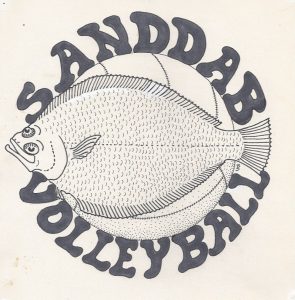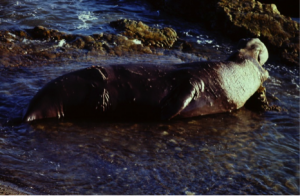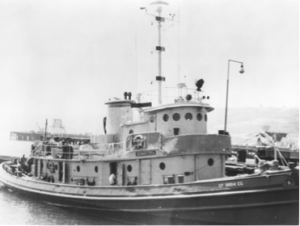By Anonymous MLML graduate ( 25 February 2016)
This is a bit of a wandering and circuitous story, but it illustrates the role MLML can play in one’s professional and personal development and life.
I grew up in Philadelphia - I was an east coast city boy.

In 1983, I was a 4.5 yr senior geology major at University of Pennsylvania in Philadelphia. Two factors during my undergraduate degree are worth mentioning (ignoring the partying!). First, although a huge amount of sediments and rocks are deposited underwater and in the oceans, I don’t think I ever really heard about oceanography or marine geology at Penn (sad, but I did eventually learn better!). Second, I had to take introductory biology as one of my last two classes so that I could get a BS instead of a BA. This doesn’t sound very significant, but ……
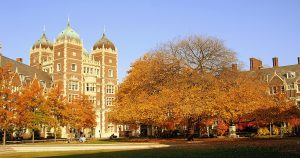
A couple things about this biology course.... The class was very large and consisted of mostly very stressed freshmen – so I actually appeared somewhat more mature than some. The lab portion was TA’ed by a biology PhD student whose name I can’t remember. During the first lab, he had to console at least one student who broke down in tears (happened a few more times throughout the semester). Afterwards, I commiserated with the TA – who turns out was a gymnastics judge in his off time. One of my roommates was on the Penn gymnastics team. As the semester wore on I became friends with my TA and toward the end of the semester my roommates, TA, and I went on a road trip to see the NCAA gymnastic championships at Penn State (saw a number of athletes that went onto the Olympics a year later).
As I finished up my BS, I decided I wanted to continue onto grad school. I applied to a number of programs, but did not get accepted to any of them. Although I had done very well in my last few years, I was still quite immature. I wasn’t really sure what I would do next.
About a month before graduation, my biology TA and I were talking about my failed plans to get into grad school and that I was trying to figure out what to do. He mentioned that one of his biology PhD student friends was doing bird research on Midway Island and was looking for a field assistant for the summer. The TA mentioned me to his friend - turns out - this University of Pennsylvania grad student in bird physiology was Russ Shea (at the time I didn’t know he did his MS at MLML in Physical Oceanography with Broenkow; he did research on the role of internal tides in nutrient enrichment in Monterey Bay). Luckily, one of his field assistants backed out and the day before graduation I was on a plane to Hawaii (starting a long history of missing graduations - and some other significant life events - to do something amazing).

I met his wife, Beverly (also a MLML grad, I believe) at Hickam Air Force Base, and boarded a Military Airlift Command C130 for a summer working on Midway Island. As a city boy, my bird experience was limited to surprising the ring-necked pheasants while waling though the forest behind our house (or more depressingly, watching the pigeons among the dirt and grime at the train station). More than a couple million breeding seabirds on that very small island in the Pacific was an incredible experience – more birds in the first hour than most people will see in a lifetime. This was Russ’ third field season doing physiology, growth, and mortality studies on sooty terns, red-tailed tropic birds, and fairy terns. I got to work with one of his other field assistants – outside, every day, commuting by whaler to the smaller of the two islands – the one with the old airbase that is now a bird sanctuary. We also did some work with Laysan Albatross and frigate birds. What an amazing experience.

Over the course of the summer, I learned to become completely comfortable walking amongst the dense bird colonies with all stages of bird life around me, on me, as well as stepping in dead bird carcasses with only flip flops on – which no longer bothers me (this later part seems similar to some of the other stories on the MLML Anniv. blog! – also interesting as I did geology because I didn’t like digging through smelly animals!). I also became a bit more cautious about swimming when the sharks that prey on the fledging albatross’ chased me out of the water during one lunch time swim. Did a bunch of snorkeling, but unfortunately, didn’t get SCUBA certified until later during my MLML time. As the summer wore on, I had lots of time to talk with Russ during the fieldwork. When I told Russ about my interest in continuing to study geology in grad school, he said “You should check out Moss Landing, it’s a great place as a stepping stone”. He went on to relay a bit about his time there in Broenkow’s lab doing physical oceanography, and how his MLML experience allowed him to move onto his very cool PhD at Penn that we were doing fieldwork for!!!

So, after the summer with Russ, Beverly, and the birds in Midway, and then a month backpacking in Hawaii (climbed Mauna Loa, hiked Kauai’s Na Pali coast), I returned to Philadelphia. I started to check out what MLML might have to offer. Not sure how I found out very much about it in the dark ages of pre-internet days…..but I applied and then arranged a meeting with MLMLs geology professor at that time - Mike Ledbetter. After getting in a car in Philadelphia with three of my friends who were in similar situations, we drove across the USA, dropped my engineering friend off in LA (got a job at Boeing or Hughes, I think), and drove up the coast to Monterey Bay. After the long drive up with my other friend, we camped out at Sunset Beach state park. I crawled out of the tent on a very cold morning, washed off with some water, put my suit, dress shirt, tie and shiny black shoes on (was still an east coast boy…..), and went to my meeting with Mike. I arrived at MLML - the “on the beach” version of MLML - which had just been finished the previous year. I’m sure I stood out (understatement). I think Mike might have said something about my clothes, but I don’t really remember. All I do remember is Mike saying – these are the several projects you could work on and I have money to pay you to do your MS research. I also remember how absolutely beautiful coastal California, Monterey Bay, and Moss Landing was. I started geology because I liked the field trips to the Appalachians, being outdoors, and not able to really believe that jobs existed that allow you to have such fun working outdoors and imagining what the earth was like in the past. Also, it was great to get out of west Philadelphia where there was lots of concrete and people who had to eat out of my trash to survive. Now Mike and MLML were offering me a great intellectual experience as well as an astounding place for me to have fun outdoors.
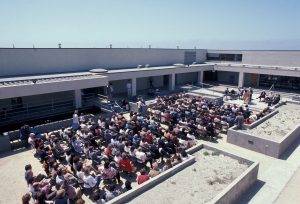
I moved to a house on Pinto Lake in Watsonville, did my MS in 2 years (on sedimentation and currents in the southwest south Atlantic; including a couple cruises down there – one out of Tierra del Fuego where Carolyn G and I almost didn’t make it back – a whole other story), learned how to scuba dive (including getting paid to scrub the algae off the bottom of the Pebble Beach Country Club pool with Don C; we got a very nice lunch in return), ate my first oysters (BBQ’d by Jim B), learned how to boogie board, started learning how to surf (getting pounded because I never asked anyone how to learn! Along with Dave A), learned to play underwater hockey (anaerobic exercise), got introduced to the Sierra Nevada (winter and summer), learned a bit about graphics, art, and donuts from Lynn M., and had many of the standard (but great) experiences that have been related on the MLML anniversary blogs (Halloween, Open House, helping to process foul-smelling, but interesting things from the slough and ocean, research cruises on Monterey Bay, etc), learn how to play beach volleyball as a short person with Jim O and others, and made lots of friends (including my wife). OK, I also learned a lot about marine geology and more specifically – paleoceanography from Mike and the other geology lab students.
For a year after my MS, I helped “run” the lab when Mike was on rotation at NSF (I did sediment grain size analyses and continued to learn how to get pounded while trying to surf). Near the end of my time at MLML, when I was deciding to go on to my PhD, Gary Greene had started spending more time at MLML. Once again, MLML people helped advise and guide me - and with both Mike and Gary support – I moved onto a PhD program at the University of Hawaii in Geophysics (where I overlapped a little with Kevin H). The preparation that MLML gave me allowed me to do quite well and I finished in 3.5 years (I also learned how to surf a bit better - although still got pounded). After a 1.5 year postdoc at the University of Tokyo, I have spent the last 23 years working for the Ocean Drilling Program at Texas A&M University. During this time, I’ve been fortunate to have participated in 18 expeditions (over 3 years at sea), did deep-sea coring, logging, and observatory installation in most major seas (except the Arctic), worked with lots (hundreds) of nice, diverse people, learned a lot about our planets history and changing climates, as well as seen lots of cool wildlife and places. In my most current role, it’s been my great pleasure to invite many hundreds of scientists to participate in our drilling expeditions – among which recently I’ve been able to invite the current MLML geologist Ivano Aiello to participate on his second drilling expedition.
So, MLML has served as a stepping stone for me. Not just a small step and not just the only one. However a very important one for me to grow, grow up, learn, and enjoy life.
I grew to appreciate very much the wide range of labs at MLML, and the people in them. I found nature and structure of MLML to be highly stimulating – having friends and colleagues in fields outside my own was wonderful – and much different than in a “normal” geology department (where my friends would all talk about the same geology things). At MLML, when I got tired of hearing about geology – I had people telling me about ichthyology, phys/chem oceanography, marine mammals, phycology, benthic fauna, eating some of the above, intertidal zones, asking for a hand in some of their fieldwork, or going down to Big Sur to see a beached blue whale. MLML turned me into a bit of an arm chair science junkie – that suits me well.

I am no longer an east coast boy, MLML facilitated my love of the outdoors, I continue to love bird watching immensely, I continue to do fieldwork outside - on the open ocean, and I’ve continually returned to Monterey Bay for vacations, surfing, hanging out with friends, and a few meetings.
MLML is a great place for many reasons. I’d encourage everyone to convey what Russ said to me in 1983: “You should check out MLML, it can be a great stepping stone”. I’ve seen this affect on many of the others who passed through MLML when I was there.
One sad note, I never stayed in touch with Russ following my Midway Island experience. Just recently, I thought I’d track him down and say thanks. Perhaps Bev and/or their kids will see this blog and know that I appreciated the life-changing opportunity Russ provided me and especially his life-changing words. My attending MLML brought me many joys and pleasures - and has had a tremendous impact on my life.







